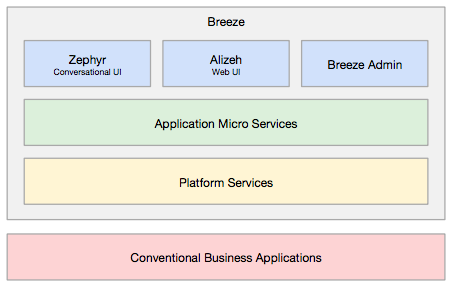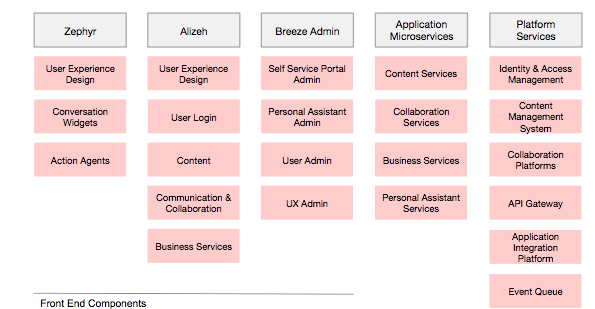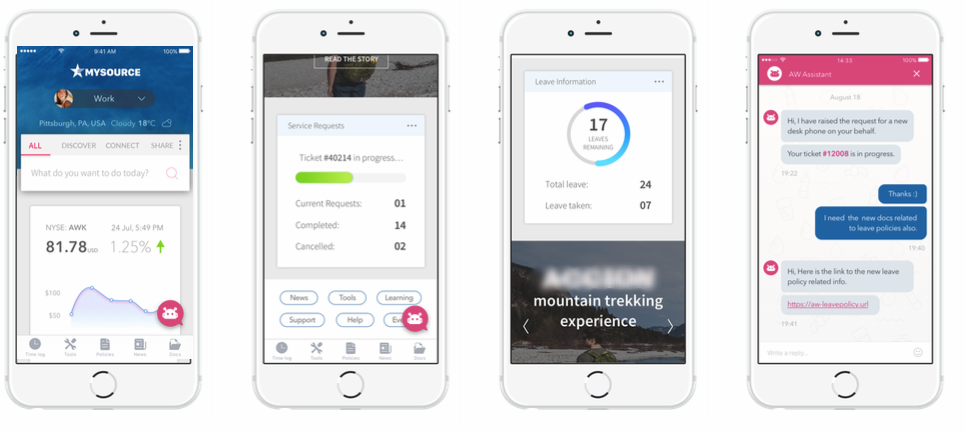Accion Breeze: A Blueprint For Digital Products
Digital products are now the foundation of the majority of business processes. Small businesses and large enterprises alike rely on well-designed digital products to run everything from customer relations to business intelligence.
But what is the foundation of digital products? Machine learning, data analytics and responsive user interfaces have changed business expectations for business applications. At the same time, microservices, cloud computing and DevOps have transformed the way these business applications can be developed.
Using iterative development, the Accion Breeze blueprint values user experience nearly above all else. Instead of starting from scratch, Accion Labs has learned from the drivers that have shaped the digital products we have built for our customers. By helping our clients through the journey of digital transformation, we have learned some important lessons about building successful business applications.
Here we walk you through the motivations, the purpose, and the design of the Breeze framework. In this article, you’ll find:
- The business and technology drivers that led to the development of a new blueprint.
- The foundation of the Breeze framework, from product design to the specific product interfaces used in the framework.
- The product design process for the Accion Breeze framework.
- The architectural blueprint for Breeze including the two interfaces, microsevers, platform services and backend business applications.
- The Breeze product component catalog.
- The uses for the Breeze framework (Zephyr & Alizeh) for business applications.
Business drivers for a new blueprint
The blueprint for Accion Breeze did not come out of the blue. Its creation was motivated by the lessons we have learned in working with clients in digital transformation. We recognize that business products are being transformed along the lines of market engagement, customer engagement, and employee engagement. Key business drivers (like conversational interfaces and the onset of AI) have brought this transformation on faster. At the same time, technology drivers have allowed our developers to stay on top of this transformation.
The goal of Accion Breeze is to stay ahead of the curve with microservices, cloud computing and responsive user interfaces. Before jumping into how Accion Breeze is built, we can first look at the drivers that led to a brand new blueprint for business application development.
Drive to Transform User Experience
The very first driver that motivated the creation of Accion Breeze was the need to transform the user experience for business applications. These days, users are looking for a natural, interactive and proactive interface with business technology.
It is no longer enough to provide a digital library or static menus. The best business applications provide logic-driven solutions to business processes. Accion saw two major drivers in this area:
Conversational interfaces that use natural language
Conventional applications are driven by digitizing manual processes. This requires users to fill in forms to capture data or take processes step by step. Today, user interface technologies and devices have capabilities that provide far richer user interface models. Voice and conversation have become a viable mechanism for the interface between user and computer systems. Accion Breeze leverages this mechanism, shifting the paradigm of user interfaces.
Proactive recommendations that move beyond static menus
Conventional applications provide menus of features and wait for users to find answers to their problems or needs. Today, applications have real time access to user data. This can be used to predict needs and proactively provide personalized recommendations. The process uses AI and machine learning (see below). Where predictions do not address users’ needs, users should be able to find what they need by asking questions in a natural language rather than scrolling through deeply nested menus.
This transformation of the user experience is at the foundation of Accion Breeze. But the platform’s creation was also informed by a larger business driver.
Drive to Build a Digital Domain
On top of user experience, business applications increasingly rely on an established digital domain using cloud computing. With complex applications, user experiences are no longer segmented by specific processes or even departments. Enterprises can now build an entire digital domain for their operation. Accion Breeze leverages this, and recognizes two areas in particular to home in on:
AI driven knowledge base that combines structured and tribal knowledge
Conventional knowledge management was treated as a process of digitizing documents or databases that represent a structured knowledge of the organization. The depth of this knowledge is limited by the documentation process. Users carry tribal knowledge that is not structured - and is difficult to represent in documentation. In contrast, AI technologies process multiple digital data. This includes photographs, videos and voice. These data are much better at capturing tribal knowledge than documents. Business applications can combine conventional structured knowledge with tribal knowledge, allowing users to access the most relevant knowledge where and when they need it.
Automation - building products with quick releases
Application development processes today are driven by automation. Product owners can drive and deploy new features on the fly without requiring long release cycles. This automation drives the cost of development down, making the build vs. buy decision tilt closer to the build option. Organizations can create digital products that incorporate their core knowledge and help retain their competitive advantage in a crowded market.
Technology Drivers At The Core Of Accion Breeze
On top of these business drivers behind Accion Breeze, we recognized quite a few technology drivers. These specific developments in technology represent an opportunity to change the paradigm of business application development. They are less the purpose behind Breeze and more the components that give power to the platform.
Some of the specific technology drivers behind the Accion Breeze platform include:
- AI & Machine Learning
- Data Lake & Big Data Analytics
- Natural Language Processing (NLP)
- Robotic Process Automation
- Responsive User Interfaces
- Voice Interface & Chat Bots
- Cloud Computing, Containers & Serverless Computing
- Microservices
- User Generated Content & Social Media
- DevOps
Areas of Transformation Driving Accion Breeze
The final area that drives the purpose of the Breeze platform is the transformation of business processes on a larger scale. Outside of digital products and business applications, enterprises are changing the way that they interact with their target audience, customers and even their own employees.
The key to business processes and practices today is engagement. The Breeze platform works toward engagement in all of these areas:
- Market Engagement: Offering authentic interactions with businesses from the start.
- Digital marketing and social networks
- AI driven market intelligence
- Engagement platform for lead generation
- Lead nurturing and conversion
- Customer Engagement: Timely and helpful interactions with business agents and/or automated responses.
- Digital delivery of products and services
- Online transactions, billing, payments and support
- Digital integration of partners and suppliers
- Employee Engagement: Increased ability for interdepartmental collaboration and integrated business intelligence.
- Core knowledge and intelligence
- Collaborative work tools
- Transforming core business process services (e.g. operations, sales, HR, finance, etc.)
Accion Breeze addresses this transformation by opening up the opportunity for greater engagement using customized and targeted business applications.
Foundations of the Breeze Concept
The concept behind Breeze is to create a blueprint for digital products. The platform leverages the business and technology drivers of digital transformation for a more enhanced user experience in developing business applications.
The Breeze platform provides four elements that help enterprises develop business applications:
- A product design process: From product vision to iterative development and release, Breeze provides a step-by-step design process.
- A technology architecture blueprint: With a microservice approach, Breeze uses the same architecture for all business applications.
- A product component catalog: The component catalog provides a blueprint for Epics in the backlog. Individual features can be broken down dependent on the product vision and requirements during the iterative development process.
- A reusable components library: Breeze may not be a WYSIWYG platform, but it does provide components that can be reused across business applications
Using these elements as building blocks, Breeze consists of the combination of two product interfaces:
- Zephyr: A conversational interface
- Alizeh: A predictive, personalized web interface
Breeze Design Process
Using Breeze as a framework for business application development proceeds smoothly because Breeze provides a clear product design process In the initial stage of design, enterprises start with a product vision and alignment of that vision with the Breeze blueprint.

Once there is blueprint alignment, enterprises can walk through the development design process step by step:
- Release Strategy: With an iterative development approach, release is broken into three stages. Stage one provides an end-to-end experience for the product, stage two incorporates user feedback and collaboration tools, and the third stage consolidates tools and enhances user experience.
- User Personal & Goals: Using a combination of a UX discovery workshop, user persona matrix and identification of user goals, Breeze focuses development on UX.
- Information Architecture: Breeze uses conversational and topical maps to create visual wireframes that fit specific user cases.
- UI Design: Breeze focuses on different interfaces for web based, conversational and mobile UI.
The Breeze Architectural Blueprint
The Accion Breeze blueprint is made up of five key elements: the Zephyr and Alizeh interfaces, application microservices, platform services and conventional business applications.

Breeze provides both front-end and backend components. On the front end are the Zephyr and Alizeh interfaces, and on the backend are the application microservices and platform services, whereas Breeze Admin is the intersect between the front-end and backend elements.

Zephyr: This a conversational user interface allowing greater engagement with a business audience, customers and employees and consists of User Experience Design, Conversation Widgets and Action Agents. There are four key elements of Zephyr:

- Smart Search: Using natural language queries and an AI based search to create faceted search results.
- Actionable Notifications: Action widgets for immediate action in response to alerts.
- Automation Agents: Minimal manual intervention for tasks like form filling, email service, uploads, etc.
- Recommendation Engine: Tracks the context and content for user actions, creating recommendations for next steps.
Alizeh: While Zephyr is conversational, Alizeh is all about personalization. It's a personalized, self learning web user interface. and it consists of User Experience Design, User Login, Content, Communication & Collaboration and Business Services. Alizeh has following four key elements:

- Content Services: A repository of metadata for people, organizations and documents.
- Collaboration Services: Workflow collaboration tools and interpersonal communication tools.
- Business Services: A unified UI for business functions, and access to the backend of the applications.
- Recommendation Engine: The same tool implemented on the Zephyr interface - tracks user preferences.
- Breeze Admin: Manages configuration and settings for the entire platform and it consists of Self Service Portal Admin, Personal Assistant Admin, User Admin and UX Admin
- Application Microservices: Provide backend APIs to all the frontend components. They are exposed through an API Gateway. This also allows modules to be agnostic of platform services.
- Platform Services: Shared platforms that support all the Application Microservices. Some of the platform services are used only for individual applications while others are shared by all applications.
- Backend Business Applications: The final element of the Breeze blueprint is backend business applications. External to Breeze, these applications are integrated with the enterprise platform. The Accion Breeze platform can be integrated with nearly any business application you can think of.
Putting It Alltogether
An understanding of how Zephyr and Alizeh approach business applications is not complete without covering what the UI frameworks look like in practice. Zephyr fits a wide range of business processes, across company sizes and industries. One of Accion customer, a large enterprise company, wanted to enhance employee engagement, allowing employees to feel connected with each other and with the company. Accion conducted a user survey and usability workshop to assess needs. We proposed a Conversational Interface Platform that integrated multiple backend enterprise applications to provide conversational widgets. This helped address the most frequently cited frustrations of employees, enhancing shared values and corporate culture.

Since Alizeh and Zephyr are designed for a better user experience in business applications, the two interfaces can be combined on both web and mobile platforms. The combination customizes the business application while maintaining the conversational nature of Zephyr and the content strength of Alizeh.
The Zephyr and Alizeh interfaces leverage the iterative development of the Breeze blueprint and business application drivers to create a cutting edge framework for application development. The framework can be used across business processes, bringing microservices and AI technology into day-to-day operations. Contact us for more information about using the Accion Breeze framework!
